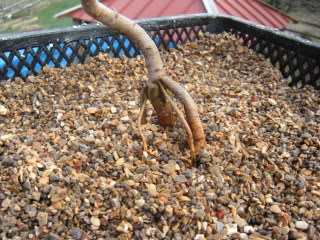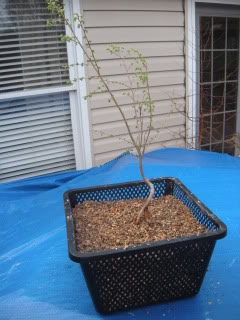The Tourniquet Method
5 posters
Page 1 of 1
 The Tourniquet Method
The Tourniquet Method
Hey all,
I've had this tree for probably 2 years or so. It is a small Chinese Elm that was given to me as a small sapling from a friend. I really wanted to beef the tree up, so I threw it into a pot. Not caring about the nebari it grew very poorly. Here is what it looks like today:


I would like to do the tourniquet or ring bark method with this tree to create new nebari. However, it was brought up by another member on another forum that this trees trunk may be too small to do this method. Here is the tree, the trunk is less than half an inch:

I've had this tree for probably 2 years or so. It is a small Chinese Elm that was given to me as a small sapling from a friend. I really wanted to beef the tree up, so I threw it into a pot. Not caring about the nebari it grew very poorly. Here is what it looks like today:


I would like to do the tourniquet or ring bark method with this tree to create new nebari. However, it was brought up by another member on another forum that this trees trunk may be too small to do this method. Here is the tree, the trunk is less than half an inch:

Ryan- Member
 Re: The Tourniquet Method
Re: The Tourniquet Method
I think this is a good size for the tourniquet method BUT. I have found that you will get better quicker results from ground/base air layering. The tourniquet method is good when you have many trees to do as it is very simple to just twist a bit of wire around the base but it will take longer to take effect.
I would wait until the tree is really booming and then take the time to do the airlayer.
I would wait until the tree is really booming and then take the time to do the airlayer.
Brett Summers- Member
 Re: The Tourniquet Method
Re: The Tourniquet Method
Why not just plant the tree deeper in the pot? Why use "drastic measures" when somehing that simple will do the job?
That tree is years from bonsaihood. Plant it deeper in a deeper pot, trim roots over 5-6 years, and you might have a nice tree.
That tree is years from bonsaihood. Plant it deeper in a deeper pot, trim roots over 5-6 years, and you might have a nice tree.

JimLewis- Member
 Re: The Tourniquet Method
Re: The Tourniquet Method
JimLewis wrote:Why not just plant the tree deeper in the pot? Why use "drastic measures" when somehing that simple will do the job?
That tree is years from bonsaihood. Plant it deeper in a deeper pot, trim roots over 5-6 years, and you might have a nice tree.
I wasn't sure new roots would sprout above that mess or not.
And I know it's years from "bonsaihood", but all trees have to start somewhere.
Ryan- Member
 Re: The Tourniquet Method
Re: The Tourniquet Method
Brett Summers wrote:I think this is a good size for the tourniquet method BUT. I have found that you will get better quicker results from ground/base air layering. The tourniquet method is good when you have many trees to do as it is very simple to just twist a bit of wire around the base but it will take longer to take effect.
I would wait until the tree is really booming and then take the time to do the airlayer.
Hmm an air layer. Interesting idea. I think I will try that, thank you!
Ryan- Member
 Re: The Tourniquet Method
Re: The Tourniquet Method
Unless you are pretty confidant in your air-layering techniques, I would go with the deep planting and prune the roots periodically. This would allow the top to continue growing and thickening and provide more opportunities for nebari development. Air layering is not as forgiving.
Jay
Jay

Jay Gaydosh- Member
 Re: The Tourniquet Method
Re: The Tourniquet Method
I know there are many ways to go about things but I never really heard anyone suggesting getting the roots right ASAP was a bad thing.
I don't think of air layering as a drastic measure. Just a typical technique to get great roots.
"Me scared you scared no bonsai"
To me it gives the best chance of getting the best roots.
Make the cuts in the cambium, stick a pot over the tree, fill with medium, ensure good all round sun.
Speed of growth will be very minimal in m experience.
I don't think of air layering as a drastic measure. Just a typical technique to get great roots.
"Me scared you scared no bonsai"
To me it gives the best chance of getting the best roots.
Make the cuts in the cambium, stick a pot over the tree, fill with medium, ensure good all round sun.
Speed of growth will be very minimal in m experience.
Brett Summers- Member
 Re: The Tourniquet Method
Re: The Tourniquet Method
It's pretty drastic on a trunk as skinny as this one, and since it is going to be YEARS before this can be called a bonsai, he has lots of time to develop the roots.
There's no danged hurry in bonsai. This is an ELM, for pete's sake, and not one you'd want to spend a whole heckuva lot of effort on.
There's no danged hurry in bonsai. This is an ELM, for pete's sake, and not one you'd want to spend a whole heckuva lot of effort on.

JimLewis- Member
 Re: The Tourniquet Method
Re: The Tourniquet Method
Brett is right on this one. Elms airlayer really easily and the sooner done the better. A fine set of radial roots will add to the flair or taper in this tree extremely quickly.
Guest- Guest
 Re: The Tourniquet Method
Re: The Tourniquet Method
Thank you all for your replies!
When you say air layer you do mean air layer right? With the sphagnum moss and all? The only difference is that I would not chop the tree, but instead spread the roots that have formed from the layer out, correct? Or do you mean a ground layer where there is no moss involved? Thank you all!
And I'm pretty confident with my air layers. I've air layered many trees, mostly tropical, but I've never air layered an elm.
When you say air layer you do mean air layer right? With the sphagnum moss and all? The only difference is that I would not chop the tree, but instead spread the roots that have formed from the layer out, correct? Or do you mean a ground layer where there is no moss involved? Thank you all!
And I'm pretty confident with my air layers. I've air layered many trees, mostly tropical, but I've never air layered an elm.
Ryan- Member
 Re: The Tourniquet Method
Re: The Tourniquet Method
Ryan. Either method will work extremely well with Elms. If youve done it before then there's no threat to the trees health. I personally would remove a ring of bark and cambium, the width of the tree wide and top the substate up well above the top cut. Use a very sharp knife as well. Rotate the tree through the season for a more even spread of roots.
Guest- Guest
 Re: The Tourniquet Method
Re: The Tourniquet Method
Will is right, then when you separate the air layer you might even get the leftover roots to sprout one of the entertaining features of elms.
In respect of the some of the other comments about not doing it, if you don't try you will never learn!
In respect of the some of the other comments about not doing it, if you don't try you will never learn!

Dave Martin- Member
 Similar topics
Similar topics» pomegranate.. could this one work for Bonsai?
» tourniquet method for radial roots
» Guy wire tourniquet material to use?
» Hedge method by Walter pall.
» New method for uploading images
» tourniquet method for radial roots
» Guy wire tourniquet material to use?
» Hedge method by Walter pall.
» New method for uploading images
Page 1 of 1
Permissions in this forum:
You cannot reply to topics in this forum






